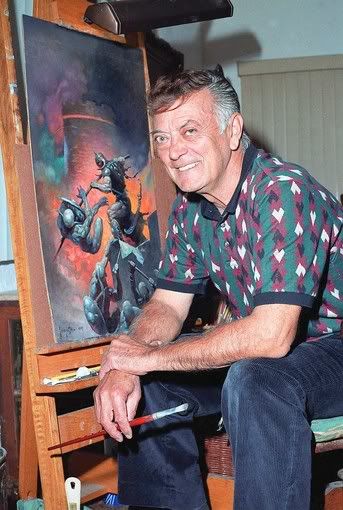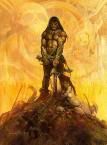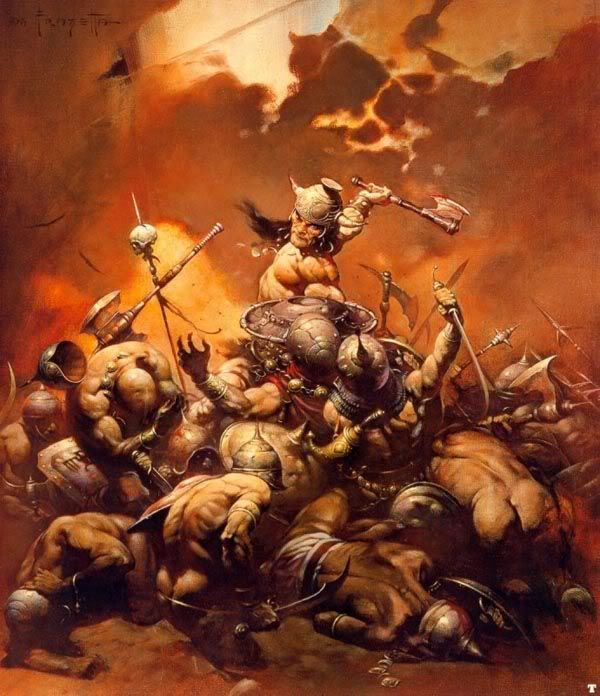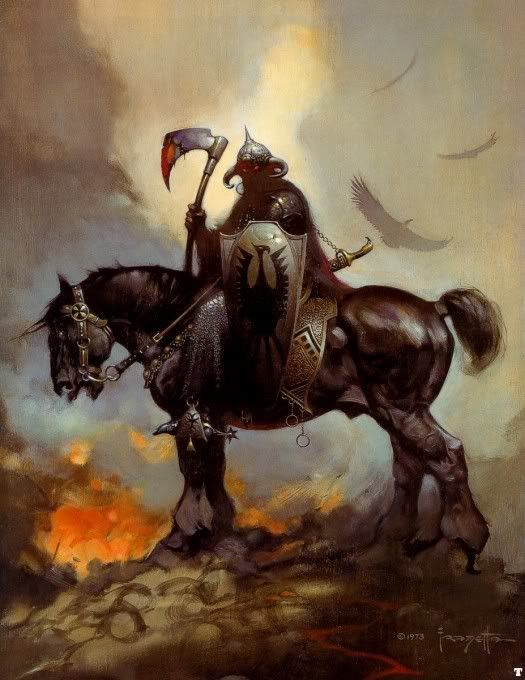
Frank Frazetta, the fantasy painter and illustrator whose images of sinewy warriors and lush vixens graced paperback novels, album covers and comic books for decades and became something close to the contemporary visual definition of the sword-and-sorcery genres, died Monday after suffering a stroke the night before. He was 82.
Frazetta was born in Brooklyn, N.Y., on Feb. 9, 1928. By age 8, he was studying at the Brooklyn Academy of Fine Art. One of his key influences was Hal Foster, the great comic-strip artist whose "Tarzan" became a compass point for Frazetta's own jungle scenes.
By 16, Frazetta was working in the booming field of illustration in New York. He toiled under Al Capp on "Li'l Abner" and on his own strip, "Johnny Comet," in the early 1950s. In comic books, he worked on "The Shining Knight" and a western hero called "Ghost Rider," but his fame would come with a paintbrush and in a more sensual sector when, in the 1960s, he began painting covers for paperbacks and magazines.
Mr. Frazetta began drawing for comic books of all stripes — westerns, mysteries, fantasies — when he was still a teenager. He was also a good enough baseball player to try out for the New York Giants.
It was his covers for the "Conan" paperbacks of the 1960s, especially, that created a new overheated vision of fantasy realms. Later in life he told an interviewer that he didn't find his strange beasts, sullen warriors or buxom maidens in the text of the books he fronted with his art.
"I didn't read any of it," Frazetta said. "I drew him my way. It was really rugged. And it caught on. I didn't care about what people thought. People who bought the books never complained about it. They probably didn't read them."
(my emphasis)

His most prominent work, however, was on the cover of book jackets, where his signature images were of strikingly fierce, hard-bodied heroes and bosomy, callipygian damsels in distress. In 1966, his cover of "Conan the Adventurer," a collection of four fantasy short stories written by Robert E. Howard and L. Sprague de Camp, depicted a brawny long-haired warrior standing in repose on top of a pile of skeletons and other detritus, his sword thrust downward into the mound, an apparently naked young woman lying at his feet, hugging his ankle.
The cover created a new look for fantasy adventure novels and established Mr. Frazetta as an artist who could sell books. He illustrated many more Conan books (including "Conan the Conqueror," "Conan the Usurper" and "Conan the Avenger") and works by Edgar Rice Burroughs (including "John Carter and the Savage Apes of Mars" and "Tarzan and the Antmen").
"Paperback publishers have been known to buy one of his paintings for use as a cover, then commission a writer to turn out a novel to go with it," The New York Times reported in 1977, the same year that a collection of his drawings, "The Fantastic Art of Frank Frazetta," sold more than 300,000 copies.
It was in the early 1960s that Frazetta found his true medium — book covers. His cover illustrations for paperback Conan the Barbarian and Tarzan books became wildly popular and indeed iconic; the popular images of these heroes today owe as much to Frazetta as they do to Robert E. Howard and Edgar Rice Burroughs. Frazetta's distinctive style also could be found on album covers by hard rock acts such as Molly Hatchet. Frazetta didn't abandon his cartoony style completely, however—his movie posters for films including What's New Pussycat? and The Fearless Vampire Hunters combine Frazetta's eye for detail and character dynamism with comic-strip and comic-book sensibilities.
He collaborated with animator Ralph Bakshi on the 1983 film Fire and Ice, which used Frazetta's character designs and Bakshi's rotoscoping aesthetic. Though a commercial and critical disappointment, the film has a cult following. In 2005, the film was released as a limited-edition DVD set, and the package includes the documentary Frazetta: Painting With Fire.
Frank Frazetta is probably best known for his striking comic book covers of Conan the Barbarian and Buck Rogers -- and for the 1982 animated film, Fire and Ice -- but once upon a time he inspired a Japanese artist who would go on to illustrate Legend of Zelda games Ocarina of Time, Majora's Mask, Wind Waker, and Twilight Princess.
Yusuke Nakano named Frazetta as his inspiration behind "muscular, expressionistic art," which he clearly brought with him to Ocarina of Time.
Guillermo del Toro, the Oscar-nominated co-writer of "Pan's Labyrinth," which he also directed along with the "Hellboy" films, said that Frazetta was nothing less than "an Olympian artist that defined fantasy art for the 20th century." The filmmaker, reached Monday in New Zealand where he is working on a two-film adaptation of "The Hobbit," said Frazetta's influence is difficult to explain to people outside the fantasy world, just as Norman Rockwell would be an elusive figure to define for someone unfamiliar with the American heartland.
"He gave the world a new pantheon of heroes," the filmmaker said by e-mail. "He took the mantle from J. Allen St. John and Joseph Clement Coll and added blood, sweat and sexual power to their legacy .... He somehow created a second narrative layer for every book he ever illustrated."

Frazetta's most famous works were in oil, but his canvases were rarely seen in museums; instead his legacy was defined by barbarians and warlocks who reached out to readers from book covers on dime-store spinner racks. But as comic books and fantasy entertainment gained a wider audience in the 1970s and '80s, Frazetta became a brand name and his original artwork became a sensation. Last November, one of his pieces, a berserk battlefield image that graced a "Conan the Conqueror" paperback, sold for $1 million to a private collector.
John Milius, the screenwriter whose credits include "Apocalypse Now," "Clear and Present Danger" and "Red Dawn," was the director and co-writer of "Conan the Barbarian," the 1982 film that was based on the warrior character created by pulp writer Robert E. Howard in 1932. Milius said Monday that it was Frazetta's muscular paintings of Conan that defined the character for him and modern generations of fans.
On a personal note...
Frazetta's wonderful artwork is partially what initially drew me to read fantasy/sci-fi.
His covers depicted Tarzan, Conan, and many others so well.... Heroes, Larger than Life
Years later, when we played D&D, I started painting t-shirts...
i copied this picture onto a t-shirt, changing the shield to a dragon...

Guest Book for Frank Frazetta


